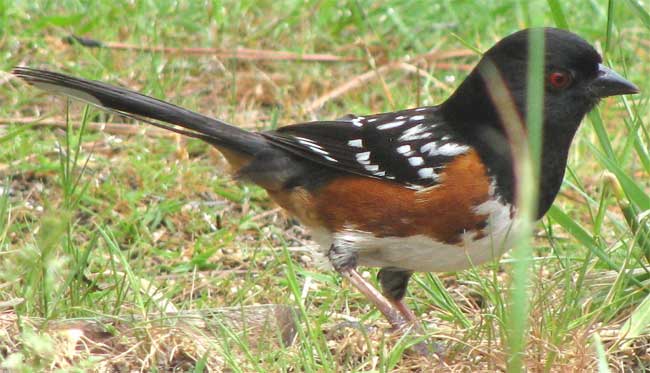Excerpts from Jim Conrad's
Naturalist Newsletter

from the the June 7, 2009 Newsletter, issued from the Siskiyou Mountains west of Grants Pass, Oregon:
SPOTTED TOWHEES
My old birding field guide illustrates the Rufous-sided Towhee distributed throughout the US and southern Canada, but admits that the species "varies geographically." Nowadays field guides usually break the old Rufous-sided species into the East's Eastern Towhee and the West's Spotted Towhee. It's Spotted Towhees, PIPILO MACULATUS, who come into my friends' backyard for the birdseed the Steller's Jays knock from the feeder onto the ground. That's one of our Spotted Towhees above.
The Spotted Towhee looks and behaves almost exactly like the Eastern species, except that the Spotted bears those conspicuous, white spots on the back while the Eastern doesn't. Also, the Eastern often is heard calling a pure "drink-your-TEEEEEEEE." I've heard the Spotted call a more ragged "TEEEEEEE" and sometimes "d'-TEEEEEEEEE," but not the whole phrase, and its other calls seem a bit more varied and harsh than the Eastern's.
One feature common to the two species is that if you're next to a thicket or scrubby area and you hear unusual rustling in dry leaves it's a good chance that it'll be a towhee, for they forage on the ground scratching like chickens. They mainly eat insects, acorns, seeds and berries. I don't believe there's anyplace were towhees might turn up more than in blackberry thickets, where you'll hear them scratching on the ground before flying up into the upper canes to see who you are.
A map showing how Spotted Towhees are permanent residents here in the northern part of their distribution and expand eastward during the summer, but during the winter expand southeastward from their southern distribution, can be seen here.